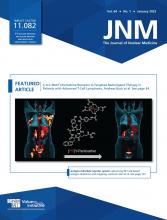TO THE EDITOR: I applaud the clear description of the development of imaging “selection” criteria for the VISION (177Lu-PSMA-617 for Metastatic Castration-Resistant Prostate Cancer) clinical trial, as published in this journal (1). Accordingly, I highlight a risk for misinterpreting the use of 68Ga-PSMA-11 PET imaging agents in selecting patients for 177Lu-PSMA-617 radioligand therapy (RLT). I refer to, first, tenuous clinical logic in claiming that an imaging test selects patients for a therapy and, second, the lack of clinical data assessing whether PET agents alone are useful in predicting which patients are and are not likely to respond to RLT.
The patient selection claim is described in labeling for the PET and RLT drugs, which have been approved by the U.S. Food and Drug Administration. The claim is based entirely on VISION clinical trial results (1–3). VISION demonstrated improved survival for patients with metastatic castration-resistant prostate cancer who received RLT (4). For VISION enrollment, imaging selection criteria integrated CT anatomic information with PET/CT findings. The criteria were developed using professional opinion and vetting of trial logistic considerations (1). The usefulness of the criteria was not piloted in clinical trials before their use in VISION (5).
Clinical practice has long recognized that selection of a therapy for a patient is generally a decision-making process integrating patient choice with the caregiver’s clinical expertise and insight regarding therapeutic options. In short, no test selects the patient for a specific therapy. Instead, a therapy is selected for the patient.
The VISION trial was not designed to determine whether the PET/CT imaging criteria were useful in predicting the response to RLT, a design limitation particularly important for patients who might be excluded from the trial because of the criteria. On the basis of imaging selection criteria, 126 of 995 patients were excluded from enrollment in the trial (4). These exclusions were determined by a single image-reader (6,7). Still, imaging criteria were not the main patient selection determiners for VISION. Among 1,179 patients assessed for trial eligibility, 176 were excluded before PET/CT imaging, whereby most of these nonselected patients did not meet the protocol’s clinical eligibility determiners (e.g., performance status and prognosis) (4,6).
Considering the assumptions and limitations surrounding the PET/CT selection for RLT, I was concerned when I heard one of the presenters at the recent Society of Nuclear Medicine and Medical Imaging annual meeting state that 68Ga-PSMA-11 helps physicians determine whether patients should or should not be considered for RLT. The implication was that VISION verified no reasonable likelihood of treatment benefit among patients with negative PET/CT results. Unfortunately, there is a disconnect between VISION data and a clinical understanding that a selection claim for a PET/CT imaging agent means the test predicts who is likely to respond to RLT as well as who is not likely to respond.
Given the magnitude of benefit observed in VISION and the limitations associated with using a single image-interpreter, some patients may have been inadvisably excluded from VISION. Indeed, 68Ga-PSMA-11 drug labeling includes a warning that emphasizes the risk for unreliability in single-reader interpretations using VISION PET/CT selection criteria (e.g., reader unanimity for negative image interpretation was 34% across a pool of 4 readers) (1). This concern is reflected in the Food and Drug Administration 177Lu-PSMA-617 approval letter, which describes a postmarketing commitment to studying the effects of RLT among patients who would have been excluded from VISION because of the imaging criteria (8).
Concern about the selection claim for 68Ga-PSMA-11 does not lessen the profound usefulness of the imaging agent in evaluating the distribution of PSMA-positive or -negative lesions among men with prostate cancer. This information may be essential to optimize treatment option considerations. Misunderstanding the selection claim may limit patient access to RLT, particularly if imaging reimbursement or clinical practice administrative factors require strident compliance with VISION selection criteria. Further, marketing of imaging drugs relies on information in drug labeling. Hence, an imaging drug manufacturer’s claim that the test selects patients for RLT may ultimately change how we think about caring for our patients—with the extreme being a prioritization of the selection test results over patients themselves. This risk may be lessened with updated drug labeling that briefly describes the strengths and limitations of PSMA PET imaging information in helping select RLT for men with prostate cancer.
Footnotes
Published online Oct. 13, 2022.
- © 2023 by the Society of Nuclear Medicine and Molecular Imaging.







